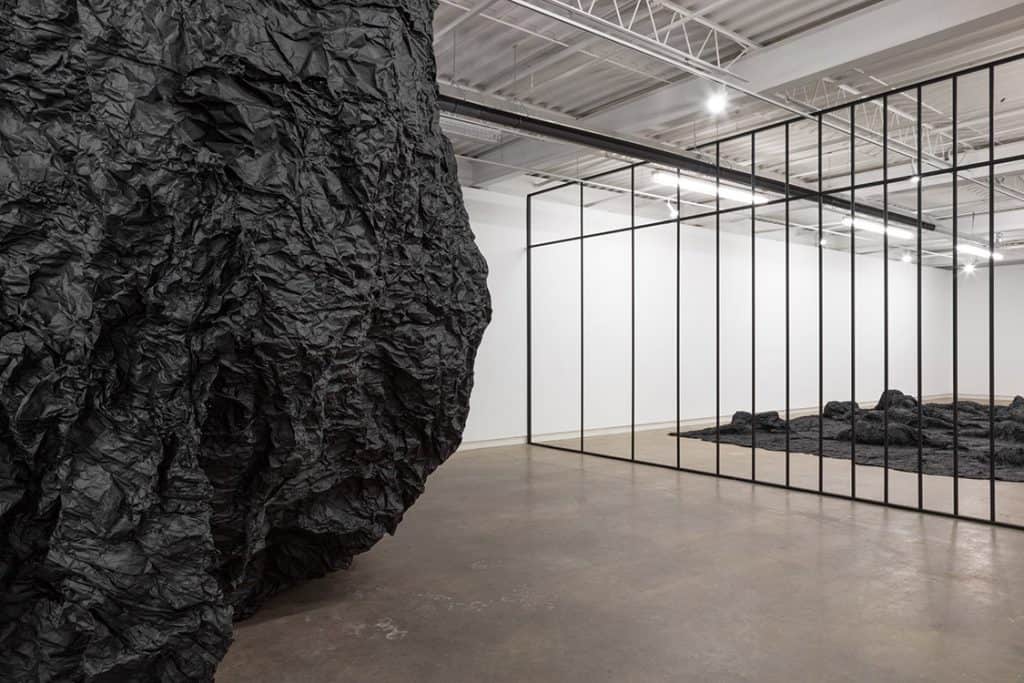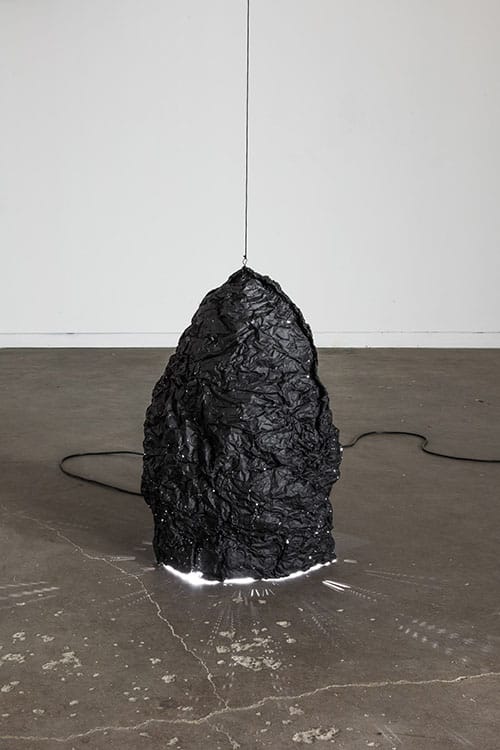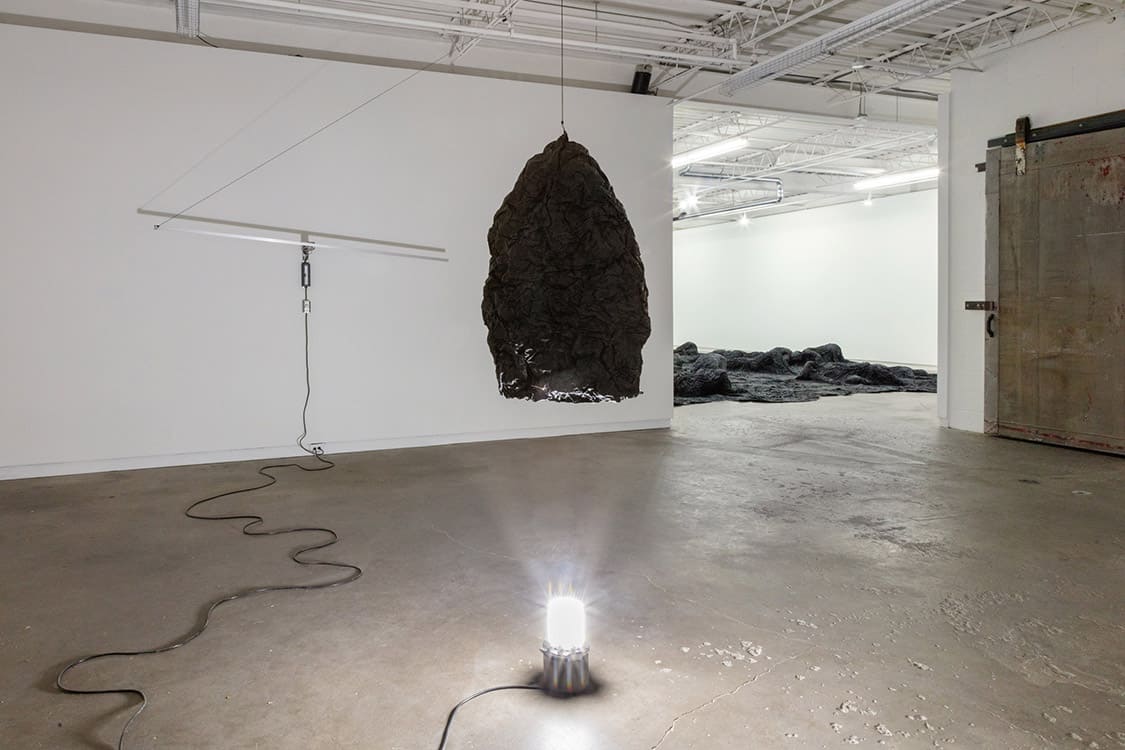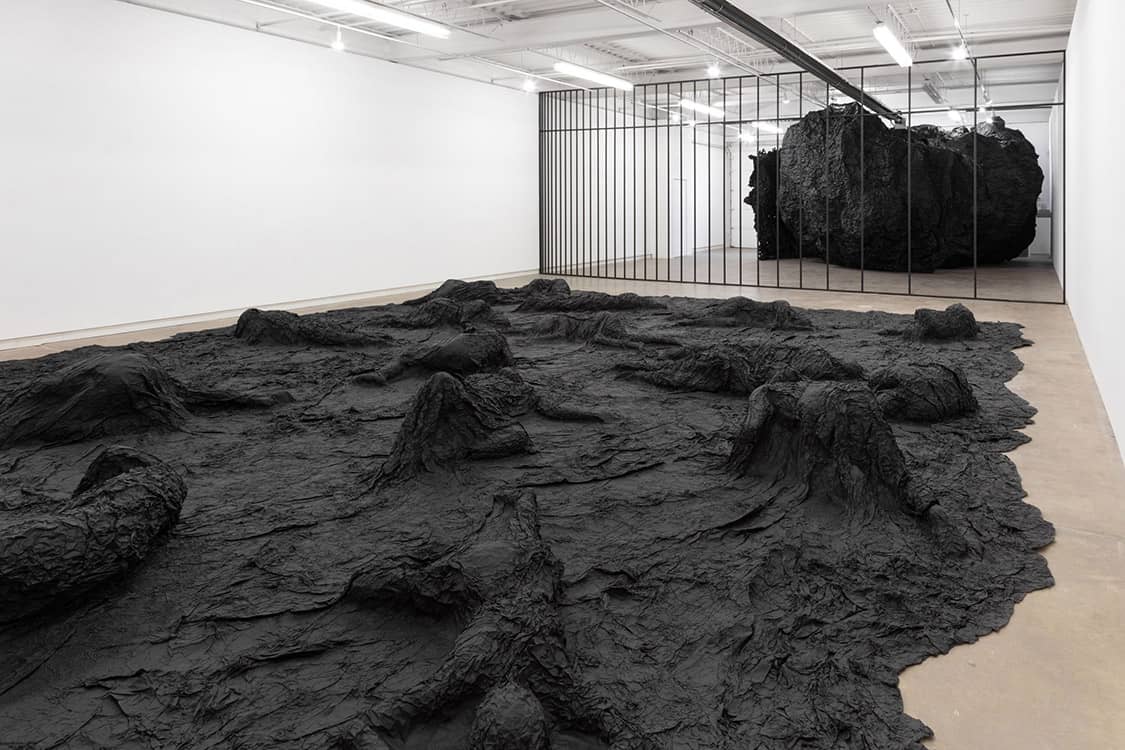Shedding – Eduardo Basualdo
 Installation View of the Eduardo Basualdo’s exhibition “Shedding”
Installation View of the Eduardo Basualdo’s exhibition “Shedding”
Eduardo Basualdo never ceases to shock his audiences with structures that totally immerse and sometimes overwhelm, consequently meaning that this show was one that was highly anticipated. Eduardo Basualdo’s large-scale installation exhibition “Shedding” opened in Scrap Metal Gallery, Toronto, Canada on the 20th of February, only to be shut down a few weeks later due to the health crisis. However, typically enjoying testing his audience and his continual focus of theatrical space, relating the viewer’s bodies to their actions, their physical presence with his art, we were keen to interact.
Adrastus Collection (AC): Fear is as real as the fiction built into your work, you even once said, “Fragility … is a very attractive state to think and feel.” Your exhibition ‘Shedding’ could not come at a more fearful time, how do you think that would be engaged with by the public, during this current pandemic?
Eduardo Basualdo (EB): I think the threat sharpens the senses. It is from that place that I am interested in mystery more than fear. I would like to be able to approach the state of alert with the work, pierce the social dimension that art consumption crosses and access intimacy. In relation to this moment we live, I think that it colors everything we see, it cannot be otherwise. We could relate anything we see to what is happening to us today. My last exhibition presented a moment of transformation, a universal change of skin, as if the sky had collapsed and we had to be reborn from the ashes. During the time it was open, each visitor associated the exhibition with the most immediate catastrophe they knew. But the association to a specific episode is anecdotal for me, no matter in what time or under what circumstances, the important thing in this project was to underline that inexorable passage of time that will turn us into ashes. This work indeed focuses on a collective catastrophe, but hundreds of them happen all the time at all times. They are part of our history and obviously of our future too. The exhibition offers a general look, dramatic but with distance. An astronomical view of humanity.
AC: You increase the viewer’s awareness of his own physical presence as you create alternative realities with your work, revealing the absurdity of institutional structures designed to restrict, during this time of so much restriction, how has that had an impact on your work?
EB: I don’t know if I work so much with the absurd, I think it’s just the doubt towards what we understand as logical. The moments of exception like the one we are experiencing sensitize us in itself. It forces us to stop, to recognize how and where we are. It confronts us with how ephemeral and vulnerable our lives are and questions us about the meaning of our daily practice. For me this moment gathers the best attributes that a work of art can have, therefore I think we have to observe it and go through it with great sensitivity. It is dramatic, but it is distant too, it is invisible and terribly material. It is hyperreal, but it is very similar to the fictions that we have imagined as well. And on top of that it’s ubiquitous.
AC: Your work is very sensorial and interactive; it runs around the real and imaginary confines of the body. Touch has been a central theme in some of your works as a module, in which you yourself have previously expressed: “It has to do with touch as the new sense that allows you to discriminate what is real. Because sight deceives, but touch does not.” And you explore the idea of “body as a permeable prison”.
Currently, touch is prohibited. The body is still a prison. Do you believe that sight might finally replace touch and we will be maimed? What are your impressions on this sensorial deficit we are experiencing?
EB: I always associated sight with our rational dimension, capable of dealing with large portions of reality, many at once and at a speed similar to that of thought. Touch is slower, much more limited and territorial. It is directly related to our body. In my work, they always appear to be contesting the sense of reality. I do not think that one is better than the other, but I do believe that sight is technologically over-stimulated and touch is increasingly forgotten. My interest is not specifically focused in this or that sense, what attracts me is to generate displacements between them. Combinations between thinking and feeling.
This pandemic sharpens polarity. On the one hand, the visual exploits, not being able to even touch ourselves exposes us to an increase in the use of interfaces. It deepens the distance. But in turn it accelerates this process so much that it makes the loss evident. It generates a kind of nostalgia for a meaning that in some way we had already resigned. At the same time, this disease impacts our materiality, it reminds us that we are a porous body that can die, it breaks with that fiction of impervious immateriality typical of the visual world. It threatens us and brings us back into contact with our body and its care. I think it is a moment of hypersensitivity, in which one aspect is not imposed on the other.
AC: How do you imagine the malleable and delicate nature of your work to adapt for future shows? Will we still be able to have the feeling even if experiencing it online?
EB: Space is central to my work, be it the three-dimensional space of an exhibition hall, that of our own body and even the imaginary space that we can experience with literature. It would be a matter of finding that new space to house works and spectators. I always film my installations and lately I realized that I have a specific look at them. Points of view, routes, times, details, I am always imagining a precise way to observe them. I read my works from narrative places, as a succession of moments. I imagine myself generating visual stories, porous, with jumps and fissures. Or quite the opposite, organizing clandestine meetings in private homes for a few participants protected by diving suits.
Installation views of the Eduardo Basualdo’s exhibition “Shedding”




Eduardo’s words touch on the limitations of present society but generate a conversation of the displacement that we already find ourselves in. Reminding us of the lack of familiarity and sensitivity society is fronting besides that of the current pandemic. The everyday challenge or the natural disaster is easily relatable to his alternate realities, and his ongoing body of work continually sets out to make his audience aware of this.
This “hyperreal” and “hypersensitivity” are described as inherent features in our landscapes if we mean to progress. However, it is the spotlighting the material of his works of art, that light it up, like “a universal change of skin” that demonstrate the fragility and essence of his work. Basualdo wishes to establish the effects of the material of his work in a fashion that grants us the opportunity to reconstruct our own thoughts. Focusing on “that inexorable passage of time that will turn us into ashes” we can envisage his dark matter and materials in parallel to Plato’s allegory of the cave. Plato’s claims, much like Basualdo, that knowledge will be gained through the senses and that, in order to have real knowledge, we must gain it through reasoning and education. With the ultimate aim of education to help people know of the Idea of the Good[1], which we should virtuously follow for future generations.
All images courtesy of the artist and in Scrap Metal Gallery, Toronto. Photo Laura Findlay.
[1] Blankenship, J., 1996. EDUCATION AND THE ARTS IN PLATO’S “REPUBLIC.” The Journal of Education, [online] Vol. 178(No. 3, Cultural Foundations & Educational Heritage, Part I), pp.pp. 67-98. Available at: <http://www.jstor.org/stable/42741826?seq=1#page_scan_tab_contents> [Accessed 5 August 2015].










